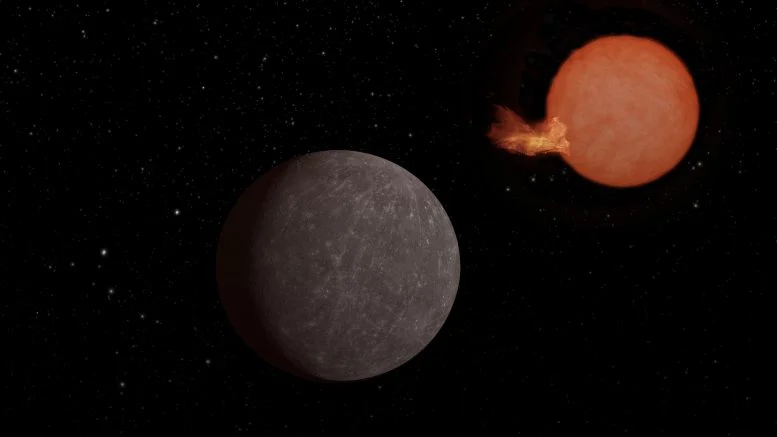Astronomers recently discovered the existence of an Earth-sized planet around SPECULOOS-3, a star similar in size to Jupiter and twice as cool as our Sun.
The SPECULOOS project recently discovered a new Earth-sized exoplanet around SPECULOOS-3, an “ultra-cold dwarf” star the size of Jupiter, twice as cold as our Sun and located 55 light-years from Earth. After the famous TRAPPIST-1, SPECULOOS 3 is the second planetary system discovered around such a star.
Ultra-cool dwarf stars
Ultra-cold dwarf stars are the least massive stars in our universe and are similar in size to the planet Jupiter. Compared to our Sun, they are twice as cold, ten times less massive, and a hundred times less luminous. Their lifetimes are a hundred times longer than our star’s, and they will be the last stars to shine when the universe cools and turns dark. Although they are much more common in the universe than sun-like stars, ultracool dwarf stars are still not fully understood due to their low luminosity. Little is known about their planets, especially in our Milky Way, even though they make up a significant portion of the planet’s population.
Discovery of SPECULOOS-3 b
In this context, the SPECULOOS consortium led by the University of Liège announced the discovery of a new Earth-sized planet orbiting a nearby ultra-cold dwarf star. The exoplanet SPECULOOS-3 b is located approximately 55 light-years from Earth. This is very close on a cosmic scale, as our parent galaxy, the Milky Way, spans 100,000 light-years.
SPECULOOS 3 is only the second planetary system discovered around such a star: “SPECULOOS-3 b is almost the same size as our planet,” explains astronomer Michael Gillon, first author of the paper. Nature Astronomy. A year, or one revolution around a star, takes about 17 hours. On the other hand, the days and nights should never end. We believe that the planet rotates synchronously so that the same side, called the dayside, is always facing the star, just as the Moon faces the Earth. On the other hand, the night needle would be trapped in eternal darkness.”
SPECULOOS project
The SPECULOOS (Search for Planets Eclipsing ULTRA-COLD Stars) project, initiated and led by astronomer Michael Gillon, was designed to search for exoplanets specifically around nearby ultra-cold dwarf stars. “These stars are scattered across the sky, so you need to observe them one by one for several weeks to have a chance of detecting transiting planets,” the researcher continues. This requires a dedicated network of professional robotic telescopes.” This is the concept behind SPECULOOS, which is jointly managed by the universities of Liège, Cambridge, Birmingham, Bern, MIT and ETH Zürich.
“We designed SPECULOOS specifically to observe nearby ultracool dwarf stars and to search for rocky planets suitable for detailed studies,” says astronomer Laetitia Delrez from the University of Liège. In 2017, our SPECULOOS prototype using the TRAPPIST telescope discovered the famous TRAPPIST-1 system, which consists of seven Earth-sized planets, including some potentially habitable ones. It was a great start!”
SPECULOOS-3 Star and SPECULOOS-3 b
The star SPECULOOS-3 is more than twice as cold as our Sun, with an average temperature of about 2600°C. Due to its ultra-short orbit, the planet receives almost sixteen times more energy per second from the Sun than the Earth and is therefore literally bombarded with high-energy radiation.
“In such an environment, the existence of an atmosphere around the planet is highly unlikely,” says Julien de Wit, MIT professor and co-director of the SPECULOOS Northern Observatory and the Artemis telescope developed jointly by the Université de Liège and MIT. and the basis of this discovery.
This planet’s lack of an atmosphere could be a plus in many ways. “For example, it could allow us to learn a lot about supercool dwarf stars, which could enable deeper studies of their potentially habitable planets.”
Future work with the Webb Space Telescope
SPECULOOS-3 b is proving to be a perfect target for the James Webb Space Telescope, which launches in 2021 and whose data will revolutionize the way we view the universe. “With JWST, we can even study the mineralogy of the planet’s surface!” – Admires Elsa Ducrot, a former researcher at the University of Liège who now works at the Paris Observatory.
“This discovery demonstrates the ability of our SPECULOOS-North observatory to detect Earth-sized exoplanets suitable for detailed study. And this is just the beginning! Thanks to financial support from the Wallonia region and the University of Liège, two new telescopes, Orion and Apollo, will accelerate the hunt for these fascinating planets.” will soon join Artemis on the Teide plateau in Tenerife,” concludes Michael. Gillon.
Reference: “An Earth-sized exoplanet discovered orbiting near ultra-cool dwarf star SPECULOOS-3” May 15, 2024, Nature Astronomy.
DOI: 10.1038/s41550-024-02271-2













